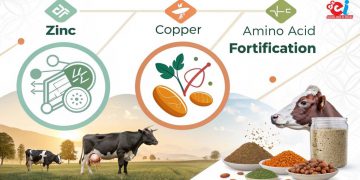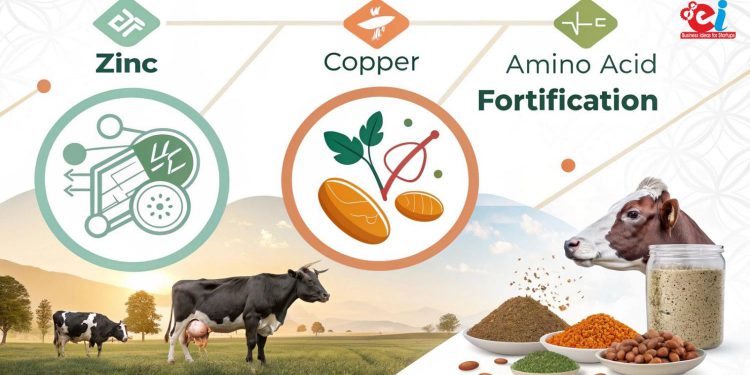These days livestock farming deals with optimizing animal health and productivity by incorporating a multitude of factors — from feed macronutrients to the more basic dietary needs prescribed. It is a science in its own right. Everything now revolves around the correct blend of essential amino acids, animal feeds, and feed additives, which are propped up by micromineral like animal nutrition supplement. Supporting growth, sustaining strong disease resistance, and reproductive efficiency grade of poultry, swine, aquaculture species, and cattle demand the infusion of indeed small, but critical micronutrients along with optimal feed ration. These also aid in sustaining feed conversion rates.
Farmers, alongside feed manufacturers seeking to balance these factors, have to deal with ever-increasing global demand for quality animal products such as milk, meat, or eggs. This phenomenon introduces a competitive market dedicated to sustainably boosting animal performance and productivity. This is why supplementation with trace minerals, copper, zinc, as well as essential amino acids give an edge over the rest. Supplementing scientifically engineered feed formulations with these compounds enables supporting enzymes, oxidation defenses, immune functions, and even gene expression.
In this comprehensive guide, we analyze the potential impact of trace elements and amino acids on the animal nutrition supplement, including their methods of action, consequences of deficiency, and demonstrating how economic productivity, efficiency, and profitability can be improved with precise additive fortification. Additionally, we show how nutrition consultants and companies like the Niir Project Consultancy Services (NPCS) help industries to devise efficient animal nutrition supplement with optimally designed, economically and nutritionally trace element fortified animal feeds.
The Developing Discipline of Animal Nutrition Supplement
Livestock and poultry have outgrown traditional feedstuffs. For the past few decades, the science of nutrition has evolved towards precision animal nutrition feeding which goes beyond simply meeting energy and protein levels to optimizing their biological functions. With the intensification of farming practices, there is little or no scope for nutritional wastage or imbalance.
Incorporation of animal feed additives with essential trace elements, like zinc and copper, as well as essential amino acids has transformed from optional to mandatory within compound feeds. While carbohydrates and fats supply energy, proteins serve as building blocks; trace elements and amino acids play a critical role as metabolic regulators and co-factors for various enzymatic, hormonal, immune, and reproductive functions.
Specific reference is made to zinc and copper because they are essential. This means an animal cannot make them and must get them from feed that has been processed in a way that makes them bioavailable. This is crucial not only for health and growth but also for reducing environmental pollution, antibiotic usage, and achieving export quality standards for animal products.
Zinc: The Immunity Mineral in Animal Health
Zinc is needed in more than 300 enzyme systems and is involved as a co-factor in protein synthesis, healing of wounds, reproduction, and to primary, control of the immunity system. Zinc deficiency in these diets often causes reduced feed intake, poor weight gain, dry coat/feathers, lesions on hooves and skin, and stunted growth of sexual characteristics.
Locally in birds, zinc deficiency results in poor feathering, deformities of the skeleton, and greater vulnerability to coccidiosis and bacterial infections. In cattle and swine, it can cause parakeratosis, slowed production of sperm, lower milk yield, and weak hooves.
Adding zinc in the form of zinc oxide, zinc sulfate, or organic chelates to animal feeds has shown to improve their growth performance, increase epithelial barrier strength, boost tissue regenerative capacity, and fortify disease resistance. Moreover, zinc is fundamental in the sequestering free radicals and oxidative storm without inflammation by superoxide dismutase (SOD) enzyme activation. Antioxidant detoxification relies on zinc as a vital and critical index.
Precision feeding systems now incorporate zinc at optimized inclusion rates (e.g., 30-60 ppm of zinc depending on the species and age) so that the balance between animal requirement and environmental safety is maintained. Albeit, any excess zinc in urine and feces can lead to soil contamination, which makes the use of more bioavailable organic forms more accessible to waste. There is a clear interplay between bioavailability and contamination.
Related: Cost Optimization Strategy in Zinc Bromide Production: Energy, Waste & Yield Management
Copper: The Growth Promoter and Antimicrobial Agent
Works of more complex copper, animal nutrition supplement, an essential copper is known with more activity in metabolism. It helps in iron transport, collagen construction, pigment forming copper-based enzymes activition which includes energy metabolism and immunity. This also serves as an antimicrobial agent in the gut, suppressing the overgrowth of potential pathogenic bacteria and thereby enhancing nutrient availability and absorption.
When it comes to dietary routines for poultry and pigs, copper is incorporated not only to fulfill the explicit dietary needs but also to assist in growth enhancement. Growth rate, feeding efficacy, and diarrhea frequency improves significantly with copper supplementation above nutritional demands (125-250 ppm in pigs). Such pharmacological effects are the results of copper interacting with gut microbiota and certain digestive enzymes.
On the other hand, copper supplementation can lead to toxic conditions, particularly when given to sheep due to their heightened sensitivity. Effective and safe feed formulation demands the use of a copper source of copper like copper sulfate, tribasic copper chloride (TBCC), or organic copper chelates to copper.
Moreover, copper also contributes to antioxidant systems, especially as a cofactor of cytochrome oxidase and ceruloplasmin. Its presence strengthens the body’s defenses against stress induced immune suppression, particularly in high ammonia animals raised under intensive farming conditions.
Essential Amino Acids: Building Blocks for Growth and Efficiency
If applying zinc and copper, there is no doubt that these are significant micronutrients synergistically working with the building blocks of proteins—amino acids. The diet must include certain essentials like lysine, methionine, threonine, and tryptophan as animals do not possess the means to synthesize them.
Deficiencies or imbalances in the critical amino acids bring about poor weight gain, low feed conversion efficiency, reduced egg production, sub-optimal feathering, and an overall decline in carcass quality. However, strategic supplementation optimizes dietary protein utilization, mitigates nitrogen waste, and decreases feed expenses.
The addition of synthetic amino acids permits feed manufacturers to design low-crude-protein diets devoid of performance compromise, thus reducing costs and enhancing gut health. When coupled with trace elements such as zinc and copper, the synergistic effects of these amino acids aid in maximizing livestock and poultry productivity.
Appropriate dietary supplements composed of amino acids have the potential to enhance skeletal development, reproduction, and even stress tolerance which are critical in dairy farming, broiler production, and swine weaning operations.
Bioavailability and Formulation Considerations
The concentration of bioavailable trace elements such as zinc and copper, alongside essential amino acids plays a major role in determining the efficacy of livestock feeds, which directly depends on how well the animal can absorb and wield the nutrients provided from the feed. Organic forms offer better bioavailability than inorganic salts but tend to be more expensive.
When it comes to antagonist interactions, there is an issue. A diet containing high amounts of calcium, iron, or phytates can block the absorption of zinc and copper. Moreover, inadequate ratios of certain amino acids can restrict protein being synthesized even when there are sufficient proteins available.
Modern mills have adopted premix technology, which ensures that trace elements and amino acids are added into the feeds in a uniform manner. Inclusion rates need to be tailored for the specific species and aligned with NRC guidelines, stage of production, environmental factors, and composition of the overall diet.
Verification through feed trials, digestibility studies, and performance benchmarking is critical validating efficacy. Today, formulation software allows for dynamic changes to be made based on the relative costs of raw materials and the nutrients required.
Related: Business Plan for Starting Animal Feed Production
Regulatory Guidelines and Safety Protocols
The use of trace minerals and and amono acids are added to animal nutrition supplement only up to the point where it does not compromise animal safety, ecological balance, or food quality. In India, the Bureau of Indian Standards (BIS) and FSSAI oversee the use of feed additives. They, along with the European Food Safety Authority (EFSA) and the U.S. FDA, set limits and assess risks for obtrusive additives at a global level.
An excess of trace nutrients, for instance, zinc and copper, poses a risk of heavy metals being stored in the tissues of animals which could be hazardous to human health. Accurate records of all constituent formulations must be kept by the feed producers who wish to attain certification as well as have third-party testing done on them.
GMP along with HACCP guidelines are to be followed to avoid residue containing formulations, especially by the exporter oriented meat and dairy producers. Working with consultants, like Niir Project Consultancy Services (NPCS), can design compliant feed formulations that meet efficiency standards at the national and international level.
Strategic Business Opportunities for Feed Manufacturers
There are untapped opportunities for added value within the feed industry in producing animal feed fortified with essential amino acids, zinc, and copper. Difference in branding, increased prices, and market capture is made possible through precision micronutrient supplementation. While bulk feed selling has begun to transform into a commodity, having set division enables differentiation.
Premixes can be sold to feed mills, integrators, cooperatives, or directly to farms. Customers can be rewarded with loyalty and increased demand through custom species or lifecycle stage premixes.
Growth scope can be achieved by innovative delivery formats like water-soluble powders, bolus tablets, coated granules as well as nano-formulated minerals. Those herbs along with immunity boosters, enzymes, or probiotics can enhance competitiveness in the market with multifunctional formulations.
Conclusion
The future of animal nutrition supplement will come with optimally tailored precision fortification on every element of feed, including macro energy sources and micronutrient trace elements and amino acids. The future paradigm will have animal feed supplements with critical trace elements like zinc, copper, and essential amino acids being the norm instead of optional.
Investment on effective supplementation will guarantee feed manufacturers, integrators, and livestock entrepreneurs improved productivity, minimized mortality, and better overall profitability in animal farming. Sustainability in the climate and rising awareness around meat, dairy’s quality makes responsible feed formulation strategy vital.
The right formulations, compliance with regulations, research and development, and collaboration with Niir Project Consultancy Services can help businesses unlock immense value in the agricultural economy.

















